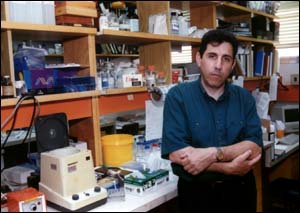
The cells in our tissues and organs are generally good neighbors. They speak to one another regularly, stay in one home for life, heed their environment and even limit their offspring to prevent overcrowding.
Sometimes, however, a "bully" cell is born or moves into the area, where it ignores other inhabitants and its surroundings, moves around and reproduces uncaringly. That "bully" is a tumor cell, and it can ruin the neighborhood.
Profs. Benjamin Geiger and Avri Ben-Ze'ev of the Molecular Cell Biology Department are studying how cells manage to maintain good neighborliness through communication and how this process goes awry in tumor cells.
Cell communication takes place when cells adhere to their surrounding substance, the matrix, and to their neighboring cells. This adhesion anchors cells in one place and enables them to link up to form tissues and organs and to exchange signals that control their behavior. Molecules known as junctional proteins, found in and just under the cell membrane, join cells with the matrix and with their neighbors, and carry adhesion signals to the cell interior.
Tumor cells are known to be associated with poor adhesiveness, and Geiger and Ben-Ze'ev believe this contributes to cancer in two ways. First, while normal cells receive signals to stop reproducing when they reach a certain density, the lack of adhesion to the matrix and to other cells that is characteristic of tumor cells means these cells do not receive such signals.
"Normal cells don't like overcrowding," says Geiger. "Once cell density reaches a certain optimal level in a normal tissue or organ, specific signals induce growth arrest. Tumor cells usually don't respond to crowding in this way; they keep reproducing, one on top of the other."
Second, the reduced adhesion of cells within a tumor means they are freer to migrate and spread, or metastasize, leading to secondary cancers.
The Institute scientists have made several discoveries that throw light on adhesion-related cell signaling and its connection with cancer. Two decades ago, Geiger identified the first junctional protein, vinculin. Around the same time, Ben-Ze'ev demonstrated that adhesion to the right matrix is essential for normal cell functioning, and that cells denied this adhesion show marked changes in gene expression, the process by which a particular gene produces its protein. Uncontrolled growth, the hallmark of cancer, can proceed in the absence of adhesion.
More recently, Ben-Ze'ev and Geiger found that in tumor cells some junctional proteins, such as vinculin, actinin and plakoglobin, are present in reduced amounts or are absent altogether. When they genetically manipulated human kidney cancer cells to contain these proteins, tumor growth was inhibited.
"This suggests that a reduction in junctional proteins is probably an essential step for tumor formation," says Ben-Ze'ev.
This research also produced an unexpected finding. In their engineered tumor cells, Ben-Ze'ev and Geiger noticed that plakoglobin was not located in its usual place under the membrane, but had made its way to the cell nucleus and was apparently suppressing tumor growth from there. This led to their realization that in normal cells plakoglobin is present also in the nucleus, albeit in minute amounts, as well as under the membrane. The scientists suggest that this "dual nationality" for a molecule such as plakoglobin might be a previously unknown means to control cell growth -- the molecule not only affects cell adhesion and signaling from its usual place under the membrane but probably also acts on genes involved in regulating cell growth, affecting their expression. While the mechanism by which the protein enters the nucleus, and exactly what it does there, are still under study, this finding may shed further light on the development of tumor cells.
The scientists also believe that their research has the potential for helping in the design of a future cancer therapy that would aim to halt tumor growth by improving cellular adhesion and communication.
